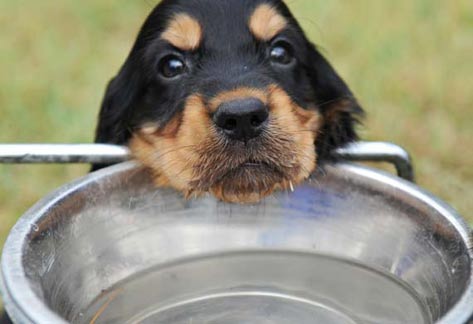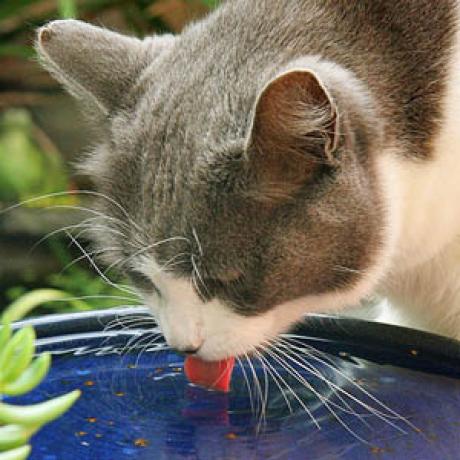Archive for the ‘Uncategorized’ Category
QUICK TIPS TO STOP YOUR DOG FROM JUMPING!
OK, I will admit it, it’s not easy to get a dog to stop jumping, especially when you get home from being away from him, and he’s so cute! However, it is possible! Now when I come home, my pup Valentino sits and waits for me to pet and acknowledge him- he’s wiggling in excitement, and sneezes and smiles with pure bliss, but he remains seated, its really cute and pleasant especially if you have nice clothes on!
When your dog does jump up, don’t interact with him, meaning do not push him down or touch him, because just doing that is approval enough. Instead stand like a tree, or give him your back. I think turning around to give him your back is a better option, then the pups paws don’t go where they dont belong, and also you won’t be suckered into looking at him either (because that is a communication sign). Then, give him a command he knows, like SIT, and once he SITS then praise and treat him. Don’t give too much attention, because it may trigger jumping again. Your dog will start to understand if he wants your attention, he must stop jumping.
Getting a Kitten? Read these Nutrition Tips!
 Kitten’s nutritional needs differ greatly from an adult cat’s requirements. After all, that little ball of fluff may double her weight during the first few weeks in her new home. And your new little kitten, will need extra energy for playtime!! Also, don’t forget to get your new kitten to the vet as soon as you can for his or her’s first check up!
Kitten’s nutritional needs differ greatly from an adult cat’s requirements. After all, that little ball of fluff may double her weight during the first few weeks in her new home. And your new little kitten, will need extra energy for playtime!! Also, don’t forget to get your new kitten to the vet as soon as you can for his or her’s first check up!
WHAT KITTENS NEED
All cats, kittens included, have similar needs for fat, most vitamins and some fatty acids. But when it comes to protein, a growing kitten needs more that an adult cat, along with more minerals, amino acids, and some essential vitamins. Thirty percent of a kitten’s energy source should come from the protein source in his or her food. Your vet may have recommendations for a nutritious kitten food. Also this is a great website for information on nutrition- http://bestcatfoodadvisor.net/.
NOT JUST ONCE A DAY
You know how active kittens are, so you have to make arrangements for your kitten to eat 3 to 4 meals a day. One meal a day cannot supply a full day’s energy store for a kitten, with all the playing, racing, chasing, pouncing and stalking that takes place!
Don’t forget unlimited access to clean, fresh water 24/7. The water bowl needs to be checked frequently, as bowls can tip. Just because there was water in the morning, doesn’t mean there will be water left in the afternoon!
Does Your Puppy Mouth??
Mouthing is very common in puppies, especially at 4 months, teething, and 7 months, when molars come in. It’s normal canine play behavior and how they explore their worlds. And some breeds are simply very oral. In adolescent dogs, however, mouthing can become attention-seeking behavior, especially once the dog learns it works! Mouthing is not biting or nibble grooming. It is not safe and it can hurt!
(1) Do NOT use physical punishment. It can encourage some dogs to be get even worse.
(2) Use a pathetic YELP! when a puppy mouths you. In many cases this will cause the puppy to stop mouthing and start kissing you. Then withdraw your attention. Praise the puppy for an appropriate response and redirect his attention to something safe to chew on. DO THIS EVERY TIME!!
(3) With adolescent dogs, your response will be similar. Give a pained OW! and then immediately withdraw your attention. You can even leave the room to stress your point. Redirect the dog’s attention and praise. DO THIS EVERY TIME!!
(4) To avoid further mouthing issues, do NOT roughhouse with the dog/pup.
GOOD LUCK!
What to Think About Before Adopting a Pet!
Being an owner of a professional pet care company, I come across numerous people who ask for help re-homing their pet. There are many different reasons for giving up a pet, and I try not to judge and just help the pet find a new home. Re-homing a pet though can cause the pet stress, sadness and anxiety, so a goal of mine is to educate people BEFORE making that huge decision of getting a new pet. This way the pet never has to go through the stress of being re-homed because someone made a hasty decision.
The first question to ask yourself before you adopt a pet is: Why do you want a pet? Knowing why you are preparing to bring a pet home will help you determine the species and breed that will fit your lifestyle. It is easy to make a decision, based solely on emotions. Remember that puppies can be irresistible, but raising them properly takes a lot of time and hard work, while most adult dogs only require a bit of basic obedience training and a house-training refresher.
The second question you need to ask yourself is: Are you ready to make a long-term commitment? Certain pets can live for a long time, and you need to make a commitment to care for that pet for the rest of his/her life. For a dog, that could be 10 to 15 years, and for a cat that could mean up to 20 years.
 Another issue, when it comes to owning a pet, is if you will have enough time to devote to your new friend. Dogs and other pets thrive on several hours of exercise and companionship every day, and some pets that are constantly left alone can develop behavioral problems. However, if you do work long hours, or travel often, if it still possible for you to be a responsible pet owner; you can hire a professional pet sitting company to help you out!
Another issue, when it comes to owning a pet, is if you will have enough time to devote to your new friend. Dogs and other pets thrive on several hours of exercise and companionship every day, and some pets that are constantly left alone can develop behavioral problems. However, if you do work long hours, or travel often, if it still possible for you to be a responsible pet owner; you can hire a professional pet sitting company to help you out!
When you are ready to adopt, and you have thought through the tough questions posed above, you should first check out your local shelters and rescue organizations. Both are wonderful resources to find your new companion. Saving a life is very rewarding, and your new pet will be very appreciative. One-quarter of all rescue dogs are purebred, and mixed breed dogs make wonderful pets too! An advantage to adopting an older pet is that they often have the social skills to be integrated into your family easily. The staff at the shelters will spend some time with you to help you find the perfect fit for your needs.
Last but not least, one of the most important steps to take after adopting a shelter pet is to contact a reputable trainer, and a reliable pet care company. Any pet—young or old, mixed breed or purebred—will likely need some training or retraining to learn how to fit into his new household and become your cherished companion. In addition, a professional pet care company is great to have on hand when you are planning to go on vacation or are just working long hours at your job. Make sure they have liability insurance, and that the insurance covers your pet while in their care!
Good luck in your search!
Unique and Fun Trivia
Did you know Dalmatians are born white? Their spots don’t appear until about three weeks of age!
Chihuahuas are born with a soft spot on the back of their skulls like human babies, and like humans, it closes with age. They are the only breed of dog born with an incomplete skull.
Great Danes and Mastiffs were dressed in armored suits and huge spiked collars during Middle Ages to be used in battles or to defend traveling caravans. Danes were also used to hunt wild boars, which is what they were originally bred for.
Greyhounds are the fastest breed. They’re able to run up to 45 miles per hour per hour. The average dog runs 19 miles per hour.
Rottweilers were bred to pull carts, specifically butcher’s carts, in a small German town. They were first referred to as “Rottweil’s dogs.”
16 Top Household Hazards for Cats
I know as a cat owner you think you have thought of it all, but it’s better to be safe than sorry!
(1) Human medications. Never leave pills on the counter because I have seen/heard of cats eating them, despite the fact that they are NOT tasty!
(2) Insecticides. One of the most common incidents, involved the misuse of flea and tick medication such as applying the wrong ones to the wrong animals.
(3) People Food. Keep your cats away from grapes, raisins, chocolate, xylitol, avocado, gum…
(4) Plants. Click here to get a complete list.
(5) Pet Medications. Make sure they are properly dispensed.
(6) Rodenticides. Don’t use them in your homes – cats can get into most tight places.
(7) Household Cleaners.
(8) Heavy Metal Paint Chips.
(9) Garden Products. Watch out for cocoa mulch and fertilizer.
(10) Chemical Hazards. Watch out for anti-freeze, pool chemicals, paint thinners & drain cleaners.
(11) Thread, Dental Floss, Tinsel. Cats love string so watch out!
(12) Mini Blinds. Cats/kittens can easily hand themselves if they get caught in the cords!
(13) Treated Toilet Water. I have stopped using the toilet bowl tabs that clean your toilet automatically because even cats sometimes drink out of toilet bowls; they are very agile!
(14) Rubber Bands.
(15) Plastic Bags.
(16) Windows/Screens. An open window can pose a threat to a cat, even if it has a screen on it. I would’t open your windows too far. Screens can break!
How Much Water Does Your Pet Need?
Most household pets do NOT drink enough water!! This can cause health problems. But do you know why your pets might not be drinking enough water?
On the average, a dog should drink 1/2 to 1 ounce of water per pound of body weight each day; whereas cats require 2-4 ounces of water daily.
Water is essential for all life; without water, organs do not function properly. Having a constant supply of fresh water is crucial to your pet’s health. Water is the most important nutrient in your pet’s body, besides oxygen. Many pet owners think their pet is getting enough water because they leave a bowl of water for them, but they can be mistaken.
Follow these suggestions to increase your pet’s water intake, and make sure your pet stays hydrated:
1) Clean and disinfect your pet’s water bowl at least once a day.
2) It is best to change the water in your pet’s bowl three times a day, but at the very least, once a day. The fresher the water, the more appealing it is to your pet to drink!
3) Pets prefer cool water over warm water.
4) Wet food can provide another source of water to your pet. If you are just feeding your pet dry food, they will require more water. On the average, dry food has 10% water content, and wet food has 80% water content!
5) A pet fountain is a great way to help your pet drink more. It circulates the water, keeping it cool and cleans out impurities as well.
6) If you are exercising your pet, he will require more water, so don’t forget to bring some water along for the ride!
7) In the summertime, your pet will require more water.
To check your pet’s hydration level, pick up a loose piece of skin by the shoulder blades, and release it. If it falls back into place quickly, then your pet should be hydrated. If not, this can be a sign that your pet is dehydrated. In any case, if you are worried about dehydration, always contact your vet!
One of Most Common Dog Dangers

One of the most common dog dangers that people don’t think about, that probably almost everyone has in their house is….. XYLITOL.
What is xylitol? Xylitol is a type of artificial sweetener found in many sugar-free chewing gums, candies and baked goods. In dogs, it can cause a sudden drop in blood sugar. They symptoms of this dangerous condition include depression, lethargy, weakness, incoordination and seizures in some cases.
Xylitol poisoning can occur in as little as 30 minutes after ingestion. Thats a big problem when you consider that dogs are so darn good about getting into things, and can do it before we even notice them. Also another problem is, sometimes when dogs get into things, they clean up (eat) the evidence too, i.e. the wrappers!
These kinds of things do happen, so please be careful. It is safest not to give your dog any human foods. But I do give my pup carrots and the occasional peanut butter in his kong 🙂










